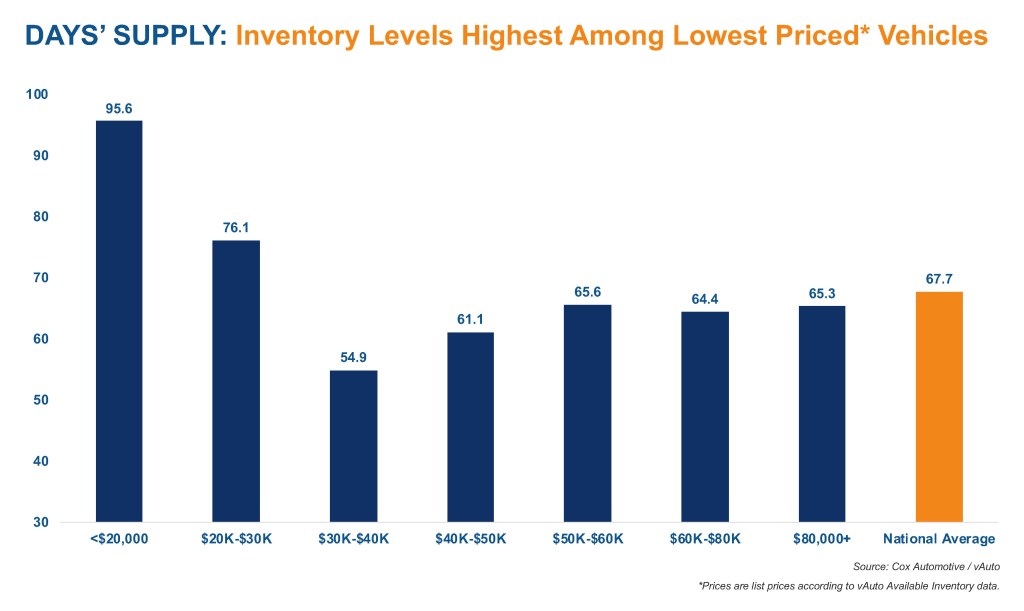Data Point
New-Vehicle Inventory Lowest in Mid-Range Price Category
Monday August 3, 2020
Article Highlights
- Mid-priced vehicle inventory is down to 55 days’ supply versus 68 overall.
- Cheapest vehicles have the highest inventory.
- Toyota Corolla, RAV4 have among the lowest inventory.
New vehicles in the range of $30,000 to $40,000 are in the shortest supply while those priced below $30,000 have the highest inventory, according to a Cox Automotive analysis of list prices based on vAuto Available Inventory data.

The days’ supply of unsold new vehicles in that mid-price category was down to 55 last week. The $40,000 to $50,000 price category had the next lowest inventory at 61 days’ supply. For comparison, the supply of all unsold new vehicles nationally stood at 68 days’ supply, a metric that has been slipping despite factories being back up and running. The average listing price for all vehicles last week was just shy of $38,000.
In contrast, new-vehicle inventory priced below $20,000 had a 96 days’ supply. New vehicles in the $20,000 to $30,000 price range is next at 76 days’ supply.
“Since vehicle sales hit rock bottom in April, the below-$30,000 segment has been slowest to recover,” said Cox Automotive Senior Economist Charlie Chesbrough. “It may seem counter intuitive that the cheapest vehicles would not be more in demand, given buyers generally seek lower prices during recessions. But those buyers likely are bearing the brunt of the downturn and may be turning away from new vehicles to used.”
Chesbrough added that the used market has tremendous selection and value for shoppers on a tight budget. “Demand for used vehicles has been running stronger than new-vehicle demand.”
Cox Automotive’s most recent data shows used-vehicle sales are running only 5% behind a year ago while new-vehicle sales were about 26% down. In some weeks, used-vehicle sales have actually been higher than they were a year ago.
Chesbrough said it is possible the below-$30,000 products will do better as the recession drags on. “That would be a silver lining for the industry as there are a lot of these vehicles on dealer lots right now.”
The mid-range price categories consist mostly of compact cars and compact SUVs as well as midsize cars and midsize SUVs.
Compact cars, a category abandoned by a number of automakers, is down to 58 days’ supply. Compact SUVs, which saw sales down less in the second quarter than the overall market, is next lowest with a 63 days’ supply.
The two best-selling compact cars, in fact, have extremely low inventory. The Honda Civic, the best-selling compact care in the second quarter, had only a 55 days’ supply. Last week, Honda was recruiting office personnel to help build Civics and other Hondas as their Ohio plants are short of workers, due to COVID-19. The Toyota Corolla had even less inventory – 38 days’ supply. Toyota, in general, has been at or second to lowest in inventory, trading with Subaru.
Similarly, in the compact SUV category, the No. 1 selling Toyota RAV4 is down to a severely skimpy 26 days’ supply. The RAV4, especially its hybrid version, was hot even before the pandemic. The No. 2 seller, Honda CR-V, had only 56 days’ supply.
Inventory of midsize cars is bloated at 77 days’ supply. In contrast, midsize utility inventory is light at 54 days’ supply.
